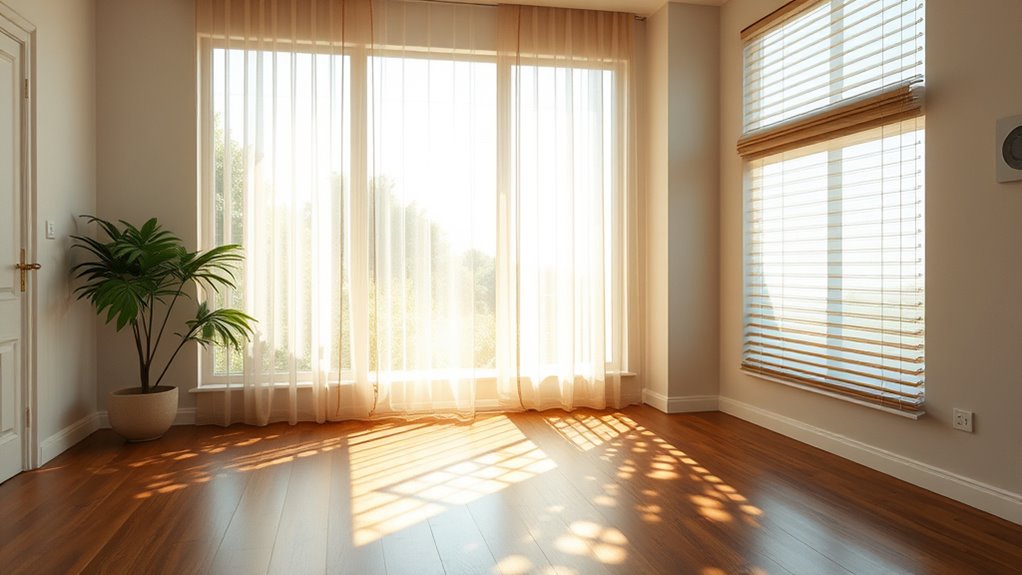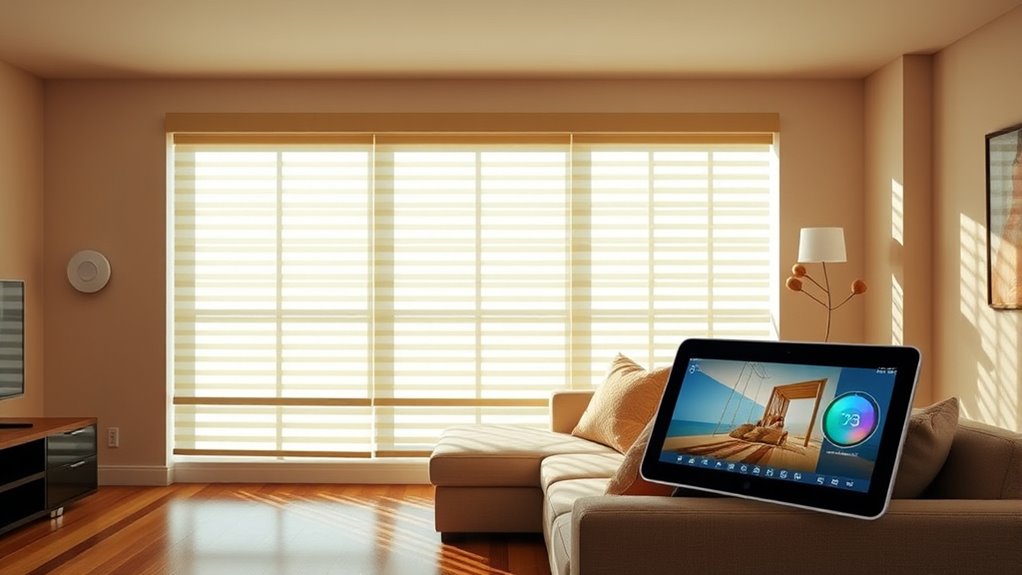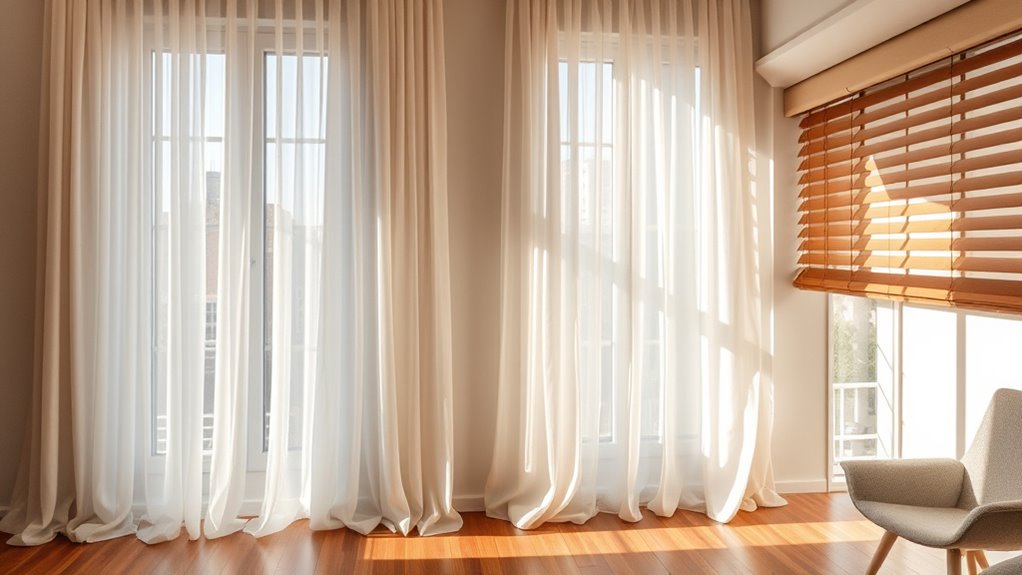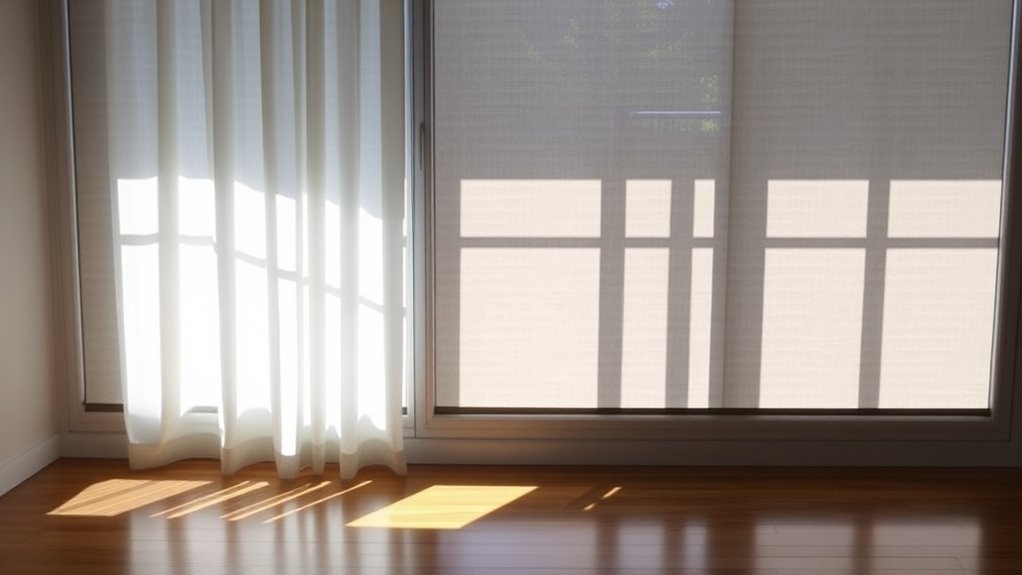Adding shades and blinds is a smart way to control light and temperature in your home. Options like honeycomb shades provide insulation, while sheer shades let in soft light. Roller and blackout shades help you customize brightness and privacy. By effectively managing heat gain and loss, these treatments can save you money on energy bills. Plus, they enhance your home’s aesthetic. Keep exploring for more tips on optimizing your space with the right window treatments.
Key Takeaways
- Honeycomb shades provide excellent insulation, reducing energy loss and maintaining comfortable indoor temperatures throughout the year.
- Blackout shades effectively block external light, improving sleep quality and controlling room temperature by minimizing heat gain or loss.
- Roller shades offer versatility in light filtering, allowing you to adjust brightness while maintaining a comfortable environment.
- Solar screen shades protect against UV rays, reducing glare and heat while preserving outdoor views.
- Automated shades enable remote control, allowing you to adjust light and temperature settings conveniently based on your daily routine.
Understanding Different Types of Shades and Blinds

When it comes to controlling light and temperature in your home, understanding the different types of shades and blinds is essential.
Honeycomb shades excel at insulation and privacy, while sheer shades provide elegant light filtering.
Roman shades offer a soft fabric look, perfect for both light and room darkening.
Roller shades are versatile and available in various materials, making them great for light control.
Solar screen shades block UV rays, allowing you to enjoy your view.
For blinds, consider wood for a timeless look, or faux wood for moisture resistance in kitchens.
Metal blinds add a modern touch, whereas mini blinds are perfect for small windows.
Vertical blinds work well for sliding doors, offering functionality and style.
The Role of Window Treatments in Energy Efficiency

While you mightn’t realize it, window treatments play a crucial role in enhancing your home’s energy efficiency. Windows can account for 25-30% of your heating and cooling energy loss, but proper treatments can significantly help.
Cellular shades and thermal curtains provide insulation, reducing heat loss in winter and heat gain in summer. Light-colored options reflect sunlight, lowering cooling costs. By controlling natural light, you can cut down on artificial lighting needs, potentially saving up to 15% on energy bills annually. Additionally, using products with energy efficiency ratings can ensure that your window treatments contribute optimally to your home’s sustainability. Implementing energy efficiency strategies such as integrating these treatments with a comprehensive home energy audit can further enhance your savings. Moreover, incorporating smart technologies into your window treatments can offer automated light and temperature control for even greater efficiency. Furthermore, utilizing geothermal heat pumps alongside window treatments can provide an efficient heating and cooling solution for your home. Understanding the importance of professional installation ensures that both window treatments and heat pumps operate at peak performance.
Adjusting treatments seasonally—closing them during peak sun hours in summer and at night in winter—maximizes efficiency. Investing in energy-efficient window treatments benefits your comfort and supports a sustainable lifestyle.
How Insulation and Thermal Efficiency Work

Window treatments not only enhance energy efficiency but also play a vital role in insulation and thermal management.
Cellular shades, for instance, trap air in honeycomb pockets, providing exceptional thermal insulation. By using insulated shades, you can significantly reduce heat loss, as they trap warm air between fabric layers.
Cellular shades create honeycomb pockets that trap air, delivering outstanding thermal insulation and reducing heat loss effectively.
The R-value measures insulation effectiveness, and higher values mean better performance. During winter, these shades keep warmth inside, while in summer, they block up to 95% of solar rays, minimizing cooling needs. Additionally, proper sun protection with broad-spectrum sunscreen is essential for protecting your skin from harmful UV rays when spending time near windows.
Proper installation maximizes these benefits, enabling you to save up to 80% of heat lost through windows. With the right choice of materials and construction, you’ll enhance your home’s comfort and energy efficiency year-round.
Benefits of Automation and Smart Home Integration

As you embrace the convenience of automation and smart home integration, managing your window treatments becomes simpler and more efficient. You can control blinds and shades remotely or through voice commands, making it easy to adjust hard-to-reach windows.
Programming them to open and close at specific times aligns perfectly with your daily routine or changes in weather. With seamless integration into your smart home system, you gain centralized control over lighting and temperature, enhancing your comfort.
Imagine creating custom scenes for different activities, all at your voice command. Plus, automated window treatments add modern appeal, increasing your property value. Additionally, integrating solar lighting options can further enhance your home’s energy efficiency and ambiance.
Embracing this technology not only simplifies your life but elevates your home experience.
Maximizing Energy Savings and Cost Reduction

Investing in shades and blinds not only enhances your home’s aesthetics but also plays a crucial role in maximizing energy savings and cutting costs.
By reducing solar gain, these window treatments decrease the need for air conditioning during hot summer months. In winter, cellular shades act as insulators, keeping warmth inside and lowering heating expenses. Additionally, implementing heat pump systems can further improve your home’s energy efficiency, providing both heating and cooling capabilities for year-round comfort. Heat pumps utilize the refrigeration cycle to efficiently transfer thermal energy, enhancing overall performance. Regular maintenance of air purifiers can also contribute to improved indoor air quality, making your home more comfortable.
You’ll also notice lower utility bills as shades block sunlight during peak hours, easing the strain on the energy grid. High-quality blinds can pay for themselves over time through energy savings, and smart scheduling optimizes efficiency based on your routine. Additionally, incorporating solar energy solutions can further enhance your home’s energy efficiency and sustainability.
Ultimately, choosing the right blinds can lead to significant long-term savings while contributing to a more sustainable environment, especially when paired with advanced technology that enhances efficiency and energy management.
Design Considerations for Aesthetic Appeal

Choosing the right shades and blinds not only enhances energy efficiency but also elevates your home’s style. Bold colors and patterns can serve as striking focal points, adding depth to your space. Unique textures like velvet or linen create a sensory experience, while custom designs enable personal expression.
Well-selected treatments can frame outdoor views, transforming windows into art pieces. Additionally, consider height and scale; long drapes can give the illusion of taller ceilings, and wide treatments emphasize expansive windows.
For a cohesive aesthetic, align your window treatments with your existing décor. Mixing materials, like wood blinds paired with fabric drapes, can introduce pleasing contrasts, enhancing the overall visual appeal of your home. Furthermore, incorporating innovative design ideas can significantly elevate your interior atmosphere.
Choosing the Right Window Treatment for Your Needs

When determining the best window treatment for your needs, consider the specific function of each room in your home.
Bedrooms often benefit from blackout shades for better sleep, while living rooms might use light-filtering options to balance privacy and natural light.
Bedrooms thrive with blackout shades for improved sleep, while light-filtering options enhance living rooms by balancing privacy and natural light.
In kitchens and bathrooms, moisture-resistant treatments are crucial to handle humidity.
Think about energy efficiency too; cellular shades can help regulate indoor temperatures and save on energy costs.
Don’t forget about privacy needs—blinds or shutters can provide the coverage you want.
Finally, weigh custom versus stock options based on your budget and installation preferences. Additionally, energy-efficient shades can significantly improve fuel efficiency and emissions in your home by reducing reliance on heating and cooling systems.
Frequently Asked Questions
How Do I Measure My Windows for Shades and Blinds?
To measure your windows for shades and blinds, start by grabbing a measuring tape.
For inside mounts, measure the width at the top, middle, and bottom, then the height from the top to the sill at both sides and the middle. Use the smallest width and largest height for ordering.
For outside mounts, add extra inches to the width and height for better coverage.
Always record your measurements immediately to avoid mistakes!
Can I Install Shades and Blinds Myself?
Yes, you can install shades and blinds yourself!
With the right tools and a bit of patience, it’s definitely achievable. Start by measuring your windows accurately, then choose the installation type that suits your needs.
Follow the manufacturer’s instructions closely, and don’t hesitate to use a level for precision. If you run into difficulties, consider asking a friend for help or looking for online tutorials.
You’ll have a satisfying DIY project completed in no time!
What Is the Lifespan of Different Window Treatments?
The lifespan of window treatments varies widely based on material and maintenance.
Mini blinds last about 2-4 years, while aluminum blinds can stretch to 4-7 years.
Faux wood and vinyl blinds typically last 3-5 years.
If you opt for fabric blinds, expect around 8-10 years with proper care.
Cellular and honeycomb shades last 5-10 years, while wood shutters can endure 10-15 years, making them a durable choice for your home.
How Do I Clean and Maintain My Window Treatments?
Cleaning your window treatments is like tending a garden; regular care keeps them vibrant.
Start with dusting weekly using a microfiber cloth or duster. For deeper cleans, follow manufacturer instructions and use appropriate methods for each material—like a damp cloth for faux wood or vacuuming fabric shades.
Inspect for wear and clean quarterly to maintain their beauty. Remember, a little effort goes a long way in preserving their charm and function.
Are There Eco-Friendly Options for Window Treatments?
Absolutely, there are plenty of eco-friendly options for window treatments!
You can choose from cellular shades that provide great insulation, bamboo shades that add a natural touch, or solar shades made from sustainable materials.
These options not only enhance your home’s beauty but also contribute to energy efficiency and improved indoor air quality.
Plus, they’re designed to last longer, helping you save money and reduce your environmental impact over time.
Conclusion
Just like a skilled conductor harmonizes an orchestra, you can master your home’s light and temperature with the right shades and blinds. Picture your living space as a canvas, where each window treatment adds a brushstroke of style and efficiency. By embracing smart technology and understanding insulation, you’re not just controlling your environment; you’re crafting a symphony of comfort and savings. So, go ahead—create your masterpiece and let your home shine in perfect balance.









